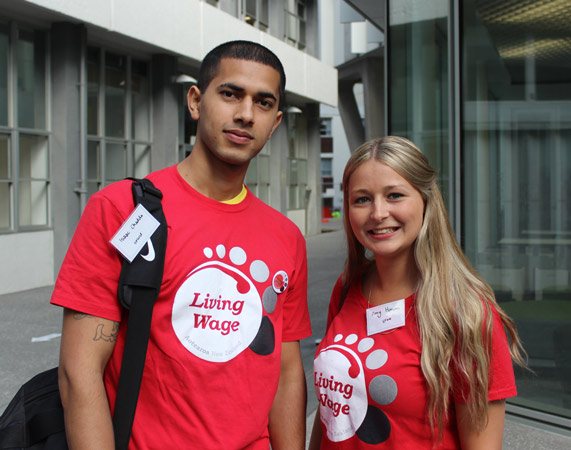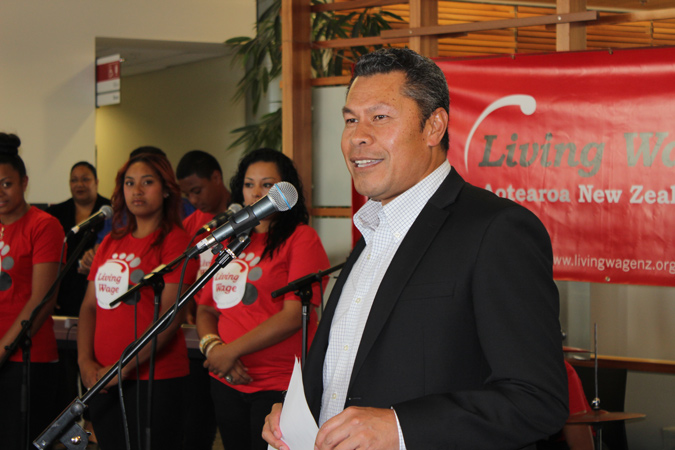You may have heard talk in the media recently about a ‘living wage’. The campaign was launched by Living Wage Aotearoa New Zealand (LWANZ), which unites a wide range of organisations who support the living wage. I spent two days at LWANZ’s Precarious Work and The Living Wage in our Communities symposium last week, which was sponsored by the New Zealand Council of Trade Unions, the Centre for Occupational Health and Safety Research and the Service and Food Workers Union. LWANZ campaigners argue that $18.40 per hour is the wage a four person family with 1.5 full-time earners would need to provide basic necessities, live with dignity, and to participate as active citizens in society. Examples of participation include having a computer in the household and being able to send children to school camps. The campaign isn’t seeking a change to the minimum wage but asks employers to voluntarily raise pay rates for their staff.

Isaac Chadda and Amy Hansen of the Service and Food Workers Union show their support for the living wage.
Living Wages around the World
The concept of a living wage is not a new one, with variations originating in multiple countries. In the last decade modern living wage campaigns similar to New Zealand’s have been launched in Canada, the US and the UK. New Zealanders have been looking to the London Citizens Living Wage Campaign as a guide for quantifying the economic impacts of the living wage. London organisations who have introduced the living wage include the Greater London Authority, KPMG, Price Waterhouse-Coopers, 13 universities, Westfield shopping centres and the London Olympic workforce. In a survey conducted of 16 workplaces who implemented the London living wage the social and economic costs and benefits were mixed.
Economic and Social Impacts
‘We can’t afford to pay it’ or ‘we can’t afford not to pay it’
The living wage campaign raises issues of both social equity and its economic impacts. The negative consequences of low wages on education, housing, nutrition and crime seem to have gone unchallenged, however, the economic impacts of a living wage are much more contentious.
A common argument cited by critics is that raising pay rates may result in increased unemployment. LWANZ states “There is no evidence that paying a living wage leads to job loss.” Whether this absence of evidence is due to a lack of research, or the absence of a relationship between a living wage and job losses is unclear.
Campaigners at the symposium cited case studies which suggested the living wage could have economic benefits. One such case study was a comparison between the two low-price retail shops Costco and Wal-mart’s Sam’s Club in the US. Although the businesses hold a similar market share, campaigners favoured Costco, who pay an average wage of US$17 per hour, versus Wal-mart’s approximate average wage of US$11.52 per hour. A larger proportion of Costco workers also receive health and retirement plans, which have a greater ratio of employer to employee financial input than the Wal-mart plans. This combination of high wages and benefits results in a low 17% turnover for Costco versus Wal-Mart’s 44% turnover. Costco enjoys a smaller, more loyal and productive workforce, and its low turnover rate dramatically reduces the cost of replacing workers. Costco’s success with high wages is encouraging for living wage advocates, but should be extrapolated carefully as its success may not be representative of all New Zealand businesses who choose to support the living wage.
Observations from the Symposium
- LWANZ calculated a single living wage for the country although differences in household factors will affect its sufficiency. For example, a family living in Auckland will pay higher rent than the country’s average and may struggle to live on $18.40 per hour. Conversely, a childless couple may receive a higher disposable income than intended. This issue stems from the living wage being attached to individual employees rather than entire households.
- The $18.40 hourly rate could be used as an anchor point to start from when bargaining for a salary. Bargaining around this anchor rather than the minimum wage may result in higher wages for employees.
- The focus has been on an hourly rate of $18.40 rather than aggregate wages (hourly rate x number of hours worked). Raising the hourly rate to increase living standards will only be sufficient if employees can work for a sufficient number of hours.
- The media often portrays businesses as charities and employees as beneficiaries who should be grateful for jobs, not biting the hand that feeds them. The reciprocity in the relationship is not always represented accurately.
- New Zealanders need to have adequate and appropriate skills and training to succeed in finding and retaining work. The responsibility for education and training is currently split between education facilities and businesses. The role that each plays may need to be reassessed due to the mismatch between the skills of unemployed New Zealanders and the skills required by growing NZ businesses.
- Many New Zealanders do not currently make use of the country’s human rights obligations when campaigning. Aligning the living wage campaign with New Zealand’s existing human rights obligations could be a powerful tool for LWANZ.
- Language should be accessible and motivating. At the symposium the living wage campaign was referred to as a battle, but also as an opportunity to work together towards common goals. Low paid jobs were referred to as precarious work, but also critical work. Small changes in language may make a large impact on the campaign’s success and the way New Zealanders relate to the cause.
Further information about the New Zealand living wage can be found at http://www.livingwagenz.org.nz/






















![20160906 McGuinness Institute - TacklingPovertyNZ Workshop – Far North Flyer [FINAL]](/wp-content/uploads/20160906-McGuinness-Institute-TacklingPovertyNZ-Workshop-%E2%80%93-Far-North-Flyer-FINAL-1-50x50.png)